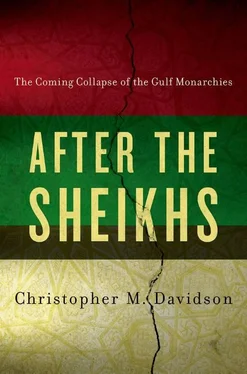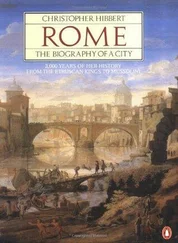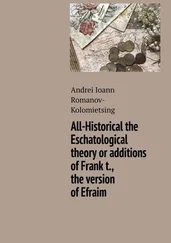After the 1970 coup, which is commonly referred to as Oman’s ‘awakening’ or Renaissance Day, [165] 109. Valeri (2011), p. 140.
the country’s state formation is best understood as a congerie of the strategies employed by its northerly neighbours. An initial attempt was made by Qaboos to share some degree of power following the appointment of his uncle, Tariq bin Taimur Al-Said, as Oman’s prime minister later in the year. However, unlike the rulers of Kuwait, Bahrain, and more recently Qatar — which all seem to have found benefit in institutionalising the position of prime minister — Qaboos soon took fright at the prospect of any co-existing authority and removed the office in 1971. Since then, in addition to being Oman’s undisputed ruler, Qaboos has been concurrently holding the positions of minister for foreign affairs, minister for defence, director of the Central Bank of Oman, and chief of staff of the armed forces. [166] 110. Valeri, (2011), p. 139; Katz, Mark, ‘Assessing the Political Stability of Oman’, Middle East Review of International Affairs , Vol. 8, No. 3, 2004.
This meant that Qaboos’ royal court or diwan quickly became something of a ‘super ministry’ in Oman — responsible for most governmental matters connected directly to the national interest. [167] 111. Valeri (2011), p. 139.
Nevertheless, other ministries continued to exist under the umbrella of a Council of Ministers, and an appointed State Consultative Council was established, ostensibly to advise the government.
In 1990 an appointed Consultative Council or Majlis Al-Shura replaced the existing State Consultative Council. Each of Oman’s fifty-nine tribal districts or wilayat were to nominate three representatives to the council, one of which would be appointed by the sultan himself. And between 1993 and 1997 the system was refined further so that larger wilayat could nominate two candidates each (including women), while the smaller wilayat nominated one candidate. By 2000, with the sultan seemingly recognising the usefulness of having an institution which provided an appearance of representative government without actually having legislative powers, the electorate was greatly expanded. About 25 per cent of the adult population — approximately 175,000 Omanis — were eligible to vote. In 2003 it was expanded again, with full suffrage, and in 2007 another round of elections was conducted for its eighty-three seats. However, as with most of the other Gulf monarchies’ parliaments, the council has remained largely toothless, with its president still being appointed by the sultan, with an executive bureau overseeing its agenda and the activities of its five permanent committees, and with its members remaining unable to compel ministers to respond to questions. [168] 112. Ibid., pp. 143–144.
Moreover, since 1996 there has also been a State Council or Majlis Al-Dawla , which is supposed to operate in parallel to the Consultative Council and perform much the same duties. Its seventy-three members are entirely appointed by the sultan for four year terms, with most being retired senior government figures, military commanders, judges, and ‘anyone that His Majesty the Sultan deems fit’. [169] 113. Ibid., p. 144.
As such, it effectively serves as a powerful counterweight to the elected body.
Perhaps the biggest distinction between Oman and the other Gulf monarchies is that Qaboos has never publicly named a crown prince or successor. Nonetheless, as with his neighbouring rulers, he has tried to use the state’s constitution to ensure the Al-Said’s dynastic longevity after his own death. An article of the constitution [170] 114. Article 6.
stipulates that a Ruling Family Council will be responsible for choosing as successor in the event of the throne becoming vacant, while a decree in 1975 clarified that the sultan is the ‘source of all laws’; since then all of the government’s legislation has been styled as a royal decree. This included the 1996 Basic Law of Oman, which not only specified that Arabic is Oman’s official language and that Sharia law constitutes the basis of all legislation, but also stated that Oman’s system of government should be that of a ‘hereditary sultanate… based on justice, consultation, and equity’. The 1996 law also provided further clarification on the sultan’s position, describing the postholder as being Oman’s ‘symbol of national unity, as well as its guardian and defender’, and stated that ‘respecting him is a national duty and that his orders must be obeyed’. [171] 115. Valeri (2011), p. 139. Quoting articles 2, 3, 5, 9 and 41 of the 1996 Basic Law of Oman.
Economic development trajectories
Since independence, or in Saudi Arabia and Oman’s case their modern state formation, oil and gas exports have undoubtedly played the leading role in the economic development trajectories of all six Gulf monarchies, albeit with some important variations. In Saudi Arabia’s case, oil was first discovered in 1938 in Dammam, close to the town of Dhahran. Given that the kingdom was, as described, beyond British control, the Al-Saud had been able to offer early concessions to American companies, with Standard Oil of California and the Texas Oil Company being joined by Standard Oil of New Jersey and Socony-Vacuum Oil in the 1940s to form the Arabian American Oil Company or Aramco. Significantly, unlike the Arab nationalist republics, the Al-Saud were careful not to nationalise fully their oil industry in the 1950s and 1960s, preferring to maintain a close relationship with their American partners and benefit from the latest technologies and market access. Nevertheless, by 1973 the Al-Saud were under pressure within the region to change their stance, given the America’s support for Israel in the Yom Kippur War. A 25 per cent government stake in Aramco was duly taken, before full nationalisation in 1980 and a rebranding of the company in 1988 as ‘Saudi Aramco’.
Kuwait’s first oil discoveries were also in 1938, although it was a British-backed company — the Kuwait Oil Company — that won the first concession. Further discoveries were made throughout the 1940s and 1950s, and in the years after independence oil exports massively increased. Similarly keen to avoid oil industry nationalisation, the Al-Sabah nevertheless also came under pressure, and in the 1970s terminated the British concessions and granted the Kuwaiti government full ownership of the Kuwait Oil Company. Of the Trucial States, Bahrain was the first to discover oil, with the wells at Jebel Dhukan being opened in 1934. Notwithstanding the Al-Khalifa’s various treaty relationships with Britain and their hosting of the British Political Resident, the Bahrain concession was initially awarded to Standard Oil of California, which had established the Bahrain Petroleum Company or Bapco some years earlier. Although the Bahraini government did take a 60 per cent stake in Bapco in the early 1980s, 40 per cent remained with the American firm Caltex — the successor company to Standard Oil. Significantly, at this time a new Supreme Council for Oil was established to oversee Bahrain’s hydrocarbon industry, with the prime minister, Khalifa bin Salman Al-Khalifa, unsurprisingly assuming its chairmanship.
As with Kuwait, Qatar was closely tied to British oil concessions following the first drilling in 1939. Later offshore concessions in the 1940s were however granted to the American company Superior Oil and Central Mining and Investment, and in the 1950s to Royal Dutch Shell. In 1973, closely mirroring the Al-Saud’s decision to part-nationalise, the newly independent Qatari government took a 25 per cent stake in the country’s oil industry before choosing fully to nationalise the new Qatar Petroleum Company in 1976. In recent years, gas has become much more important to Qatar than oil, with the government-owned Qatargas being established in 1984. Following major discoveries, most of which were located in the massive offshore North Field shared with Iran, exports of liquefied natural gas commenced in 1997, and in 2001 a second government-owned gas company, Rasgas, was established.
Читать дальше












